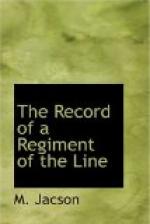A steady advance to about 1200 to 1300 yards from the position was made, when, the rifle fire becoming rather heavy, fire was opened by section volleys. The light was bad, and it was very difficult to see the enemy or estimate the distances. In a few minutes the supports reinforced, and the firing-line then pushed on to the foot of the slope, and established itself in a shallow ditch 800 to 900 yards from the position. Here it held on, firing sectional volleys, till the flank attack appeared on the hill, apparently about 500 yards from the position.
An advance by companies from the right was then ordered, and, the reserve reinforcing, a further 200 yards was gained. Some bugling and shouting was then heard on the hill. A rush to 350 yards was now made, and, after a short pause to allow the men to get breath, bayonets were fixed and the position charged, four companies assaulting the detached hill on the left, the remaining three companies assaulting the hill on which the enemy’s guns were. F and G Companies were the first to reach and take possession of the guns, the Gordon Highlanders coming up on the right shortly afterwards. The companies then moved on down the reverse slope and opened fire on the retiring enemy. On the detached hill only five of the enemy were found alive, and they showed a white flag as the hill was charged.
The Regiment was then re-formed, and held the detached hill during the night.
During the three hours it was under fire, the battalion kept line and intervals carefully throughout, and adjusted sights and fired as steadily as if on parade. It is to the perfect steadiness of the men and the absence of all crowding that the very small losses from the enemy’s fire, which at all times was heavy, can be attributed.
The battalion’s losses were:—
Captain W.B. Lafone, slightly wounded.
2nd Lieutenants Gunning, Hailey, and Green, severely
wounded.
Twenty-nine non-commissioned officers and men wounded.
Parties of men were busy during the night collecting the Boer wounded and taking them down to the laager. Among them was General Koch, who was badly hit in several places. He died of his wounds a few days afterwards in Ladysmith.
The losses of the Boers were estimated at 62 killed, 150 wounded, and 184 prisoners.
The force was moved back into Ladysmith early on the 22nd morning, the infantry by rail, and cavalry by road. The company of the Regiment and Maxim gun, which had been on Pepworth Hill during the day and the following night, got back to camp the same afternoon.
The 23rd was given up to rejoicings and congratulations over the victory, and the two Boer flags which were captured were displayed outside the officers’ mess tent.
The Free State Army had by now come across to the east, and were in the neighbourhood of Modder Station, and on October 24th a column was again ordered out with the object of assisting General Yule’s force in from Dundee.




